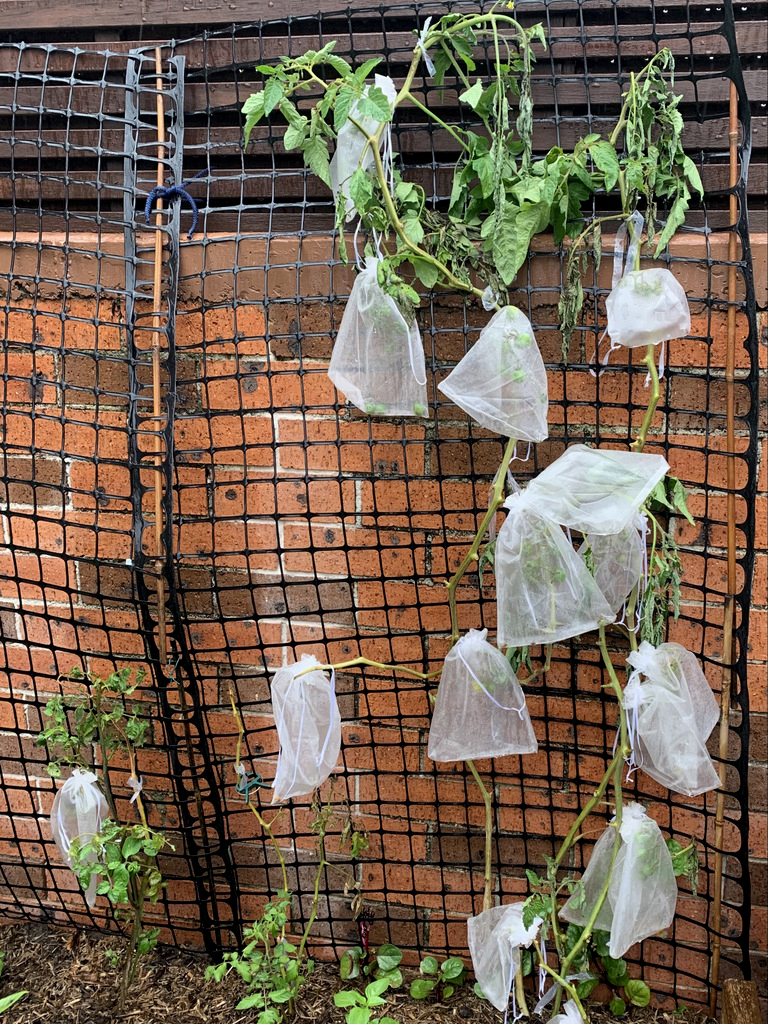Can you transplant tomato plants with fruit? Here’s how I transplanted a tomato plant with trusses of green fruit from a raised garden bed to the ground and what I would do differently next time.

Transplant Tomato Plants with Fruit – Photo © The Gourmantic Garden
Towards the end of summer, one of my tomato plants had to be moved to another location. It had been growing in a raised garden bed since early spring and I needed it vacated for a new project. Just when I thought the tomato plant had come to the end of its life, it sprouted healthy branches and became laden with fruit waiting to ripen.
I had transplanted tomato plants the week before but they had been growing in small to medium sized containers and moved to the ground. That was easy enough as the plants were relatively small and heavily pruned.
The tomato plant in question is a Sungold, a sweet cherry tomato with lots of trusses of green tomatoes and clusters of flowers. The fruit was covered in organza bags to protect it from pests and critters which were rampant during the season. The plant was rather tall, about 2 metres high and had many straggly branches growing in all directions.
I searched online about how to transplant a larger tomato plant with fruit and also asked on instagram. I was given some helpful albeit cautionary advice. Some recommended I remove the fruit and leave it ripen it on a windowsill before transplanting. All the fruit was still green with no hint of colour and if I had to go down that route, I’d get rid of the plant altogether.
In the end, it was my call and if I were to kill the plant and lose the fruit, so be it and I would learn something new along the way. After all, Sungold is my least favourite tomato to grow so I took the plunge, or rather shovel and got to task. Here’s how I did it.
How to Transplant Tomato Plants with Fruit
- The day before, I watered the plant deeply to make sure it wasn’t water stressed.
- The next day, early in the morning, I prepared the spot in the new location by digging a large enough hole and watering it well. My soil is very sandy, shallow (15cm deep in that spot) and hydrophobic so it’s not ideal at all.
- I untied all the branches that were being held upright by stakes and a tomato cage and carefully laid them on the ground.
- Using a shovel, I gently uprooted the plant ensuring the root ball had as much soil around it as possible.
- I laid the plant on its side and carried it in my arms like a baby to the new location.
- I placed the root ball in the hole as deeply as possible and quickly backfilled with soil.
- I gave the plant a long and slow deep watering with a seaweed tonic to help minimise transplant shock.
- Next, came the task of tying up the various branches against the trellis using budding tape. It was easy enough and to my surprise, I hadn’t lost any fruit, yet.
- I mulched well, watered again, breathed a sigh of relief at the completed task then crossed my fingers.

Tomato Plant with Fruit After Transplant – Photo © The Gourmantic Garden
Here’s what it looked it after transplant.
As the hours progressed, the plant started showing signs of stress. The flowers and leaves wilted and it was looking very sad. I then realised I should have transplanted late afternoon/early evening after the sun had gone down to let the plant settle out of direct sunlight. I guess I was too eager to get the job done.

Shade Cloth Over Plant – Photo © The Gourmantic Garden
Thinking on my feet, I took a long piece of shade cloth and secured it over the plant using pegs. As the day progressed, I kept checking that the soil wasn’t too dry, watered a little then left it alone.
I removed the shade cloth at night and secured it back on the next day. I did this for a couple of days. On the third day, it was overcast, cool and raining all day so no shade cloth was needed.

Day 3 After Transplant – Photo © The Gourmantic Garden
In the meantime, a couple of tomatoes had ripened which I collected and a couple had dropped in their organza bags. Some of the leaves had wilted so I pruned them. A week after the transplant, the tomato plant was still laden with fruit at various stages of ripening.
If I had to transplant tomato plants with fruit again, here’s what I would do differently:
- prune some of the lateral leaves beforehand as they are the first to show signs of stress
- prune the flowers as chances are not all will survive the move
- transplant late in the day when the sun is no longer on the garden
Overall, I’m happy with the outcome, and when I harvest the ripe Sungold tomatoes from this plant, the fruits of my labour will taste much sweeter.
Want to Know More?
You’ll find more information on how to grow tomatoes, which varieties to try, how to pair it with food and spirits, and how to use tomatoes in cocktails including a full recipe in my 260+ page digital book GROW YOUR OWN COCKTAIL GARDEN available now.


